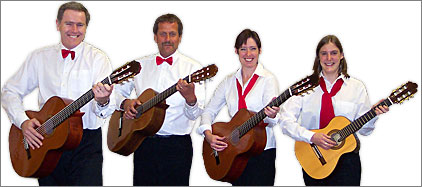
hago's four sizes of classical guitars
Read more about the contra | prime | bass | alto | our total sound
What can the Niibori guitars do?
A typical hago piece might use 3 altos, 7 primes, 2 basses and 2 contras.
Our Niibori guitars give us a pitch range of almost 5 octaves - 55% more than a guitar ensemble.
From this...
3 octaves on the fingerboard in a classical guitar ensemble

To this...
Almost 5 octaves on contra (blue), bass (green), prime (red)
and alto (orange) hago guitars
(Niibori guitars are transposing guitars, so we don't read all those leger lines below
- we read from staves like the one above)

Note pitches
Lowest note (contra) : 41 Hertz - E (same as lowest note on a double bass)
Highest note (alto) : 988 Hertz - B (fret 12). Very highest note on alto 1760 Hz - A (fret 22)
- Hear the range of our Niibori guitars in a live soundclip from 2003.
- More? See our page of string facts and our table of the pitches of all the strings on all our Niibori guitars.
hago use Hannabach and D'Addario strings for our Niibori guitars (no, we aren't being paid to say that!).
The strings have proved to have good intonation and lifetime.
Percussion - the finishing touch

From left to right - eggs, claves, cabasa
We occasionally add percussion to our pieces. The cynic might argue that the guitar's lack of sustain already singles it out from strings, brass, woodwind and even recorders, and means that the guitar orchestra sound is naturally percussive.
There's an element of truth in that, but we sometimes add percussion for the same reason that most non-marching brass bands add it - to break up the uniformity of tone across the ensemble. Another, of course, is that it is a definitive part of many modern pieces, and a proper realisation of them simply begs for percussion.
Our percussion includes chicken eggs, claves and cabasa, and of course, the guitars themselves, which offer a variety of pitches of percussion on the lower bout, the upper bout and the side...
This gives us a range of textures, all at volumes compatible with the guitars themselves.